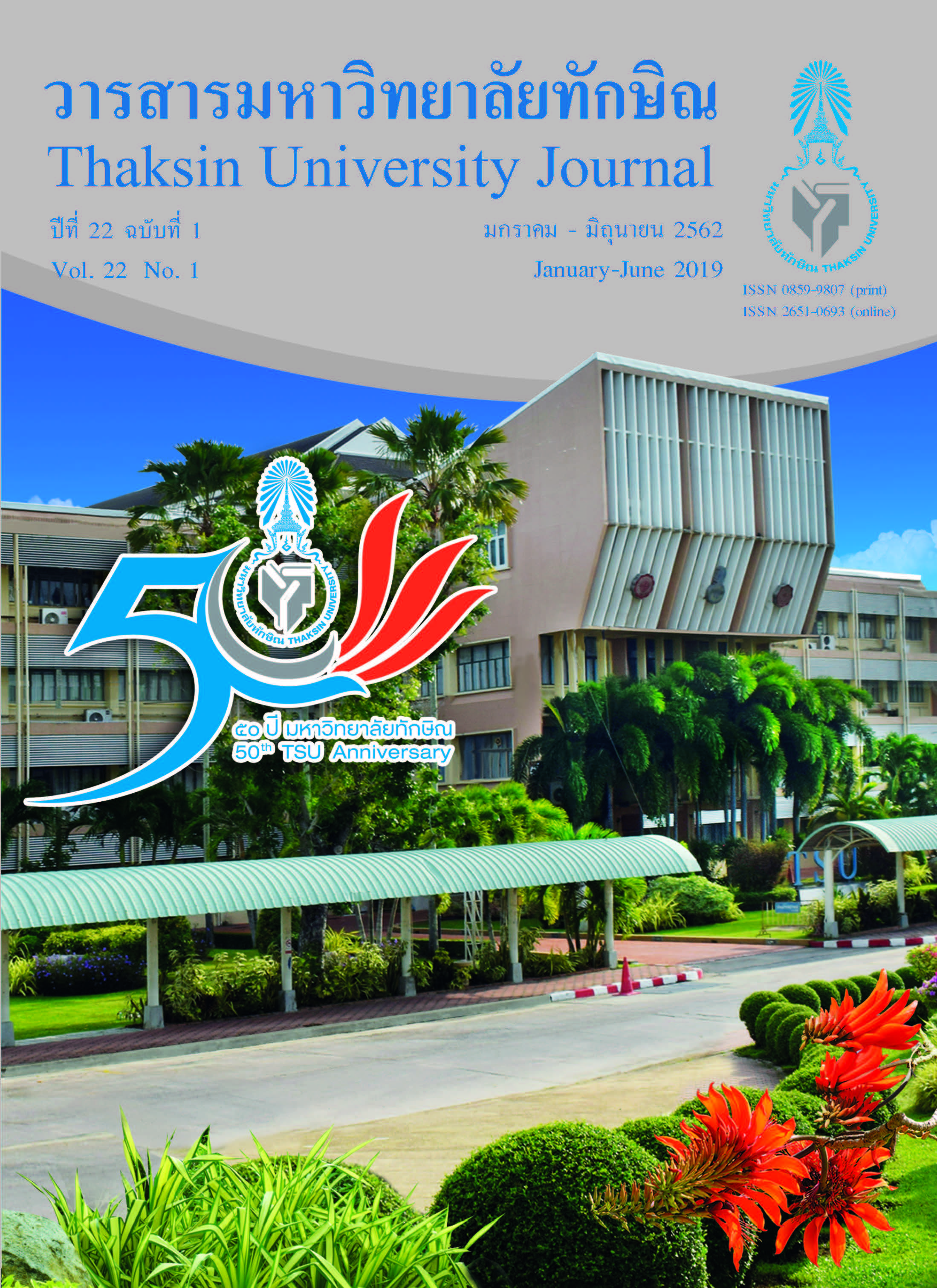Effect of Chitosan from Shrimp Shell on Quality Changes of Giant Perch (Lates calcarifer) Meat during Cold Storage
Main Article Content
Abstract
Giant Perch (Lates calcarifer) is a high-value fishery product and recognized as nutritious food source.
However, Giant Perch meat is perishable. Regarded as natural product and safety, chitosan could retard the
deterioration of Giant Perch meat. The objective of this study was to investigate the effect of chitosan on quality changes of Giant Perch fillet during cold storage. Quality changes including weight loss, pH, trimethylamine and total volatile bases, conjugated diene and thiobarbituric acid reactive substance were monitored. The results showed that chitosan can retard quality changes when compared with control with or without 1% lactic acid. The quality changes of Giant Perch fillet were varied depending on chitosan concentrations (p < 0.05). Nevertheless, the qualities of Giant Perch meat were more deteriorate as the storage time increase. Consequently, chitosan could be used in processing industry to retard the quality changes and prolonging the shelf-life of ready to cook Giant Perch fillet.
Article Details

This work is licensed under a Creative Commons Attribution-NonCommercial-NoDerivatives 4.0 International License.
References
Biological Macromolecules, 93, 41-46.
[2] Gómez-Estaca, J., López de Lacey, A., López-Caballero, M. E., Gómez-Guillén, M. C., & Montero, P.
(2010). Biodegradable Gelatinechitosan Films Incorporated with Essential Oils as Antimicrobial
Agents for Fish Preservation. Food Microbiology, 27, 889-896.
[3] Berizi, E., Hosseinzadeh, S., Shekarforoush, S. S., & Barbieri, G. (2018). Microbial, Chemical, Textural and
Sensory Properties of Coated Rainbow Trout by Chitosan Combined with Pomegranate Peel
Extract During Frozen Storage. International Journal of Biological Macromolecules, 106, 1004-1013.
[4] Ma, Z., Garrido-Maestu, A., & Jeong, K. C. (2017). Application, Mode of Action, and in vivo Activity of
Chitosan and its Micro- and Nanoparticles as Antimicrobial Agents: A review. Carbohydrate Polymers,
176, 257-265.
[5] Bonilla, J., & Sobral, P. J. A. (2016). Investigation of the Physicochemical, Antimicrobial and antioxidant
Properties of Gelatin-Chitosan Edible Film Nixed with Plant Ethanolic Extracts. Food Bioscience, 16,
17-25.
[6] Kaya, M., Dudakli, F., Asan-Ozusaglam, M., Cakmak, Y. S., Baran, T., Mentes, A., & Erdogan, S. (2016).
Porous and Nanofiber A-Chitosan Obtained from Blue Crab ( Callinectes sapidus) Tested for
Antimicrobial and Antioxidant Activities. LWT - Food Science and Technology, 65, 1109-1117.
[7] Conway, E. J., & Byrne, A. ( 1936) . An Absorption Apparatus for the Micro Determination of Certain
Volatile Substances I. The Micro Determination of Ammonia. Journal of Biochemistry, 27, 419-429.
[8] Frankel, E. N., Huang, S. W., & Aeschbach, R. (1997). Antioxidant activity of Green Teas in Different Lipid
Systems. Journal of American Oil Chemistry Society, 74, 1309-1315.
[ 9] Lee, B. J., & Hendricks, D. G. ( 1997) . Antioxidant Effects of L- carnosine on Liposomes and Beef
Homogenates. Journal of Food Science, 62, 931-934.
[10] Steel, R. G. D., & Torrie, J. H. (1980). Principles and Procedures of Statistics: A Biometrical Approach,
New York. McGraw-Hill.
[11] Xavier, K. A. M., Hauzoukim, Kannuchamy, N., Balange, A. K., Chouksey, M. K., & Gudipati, V. (2017).
Functionality of Chitosan in Batter Formulations for Coating of Fish Sticks: Effect on Physicochemical
Quality. Carbohydrate Polymers, 169, 433-440.
[12] Klompong, V., Benjakul, S., Kantachote, D., & Shahidi, F. (2012). Use of Protein Hydrolysate from Yellow
Stripe Trevally (Selaroides leptolepis) as Microbial Media. Food Bioprocess Technology, 5, 1317-1327.
[13] Bennour, M., Marrakchi, A. E., Bouchriti, N., Hamama, A., & Ouadaa, M. (1991). Chemical and Microbiological
Assessments of Mackerel (Scomber scombrus) Stored in Ice. Journal of Food Protection, 54, 789-792.
[14] Yuan, G., Chen, Z., & Li, D. (2016). Chitosan Films and Coatings Containing Essential Oils: The Antioxidant
and Antimicrobial Activity, and Application in Food Systems. Food Research International, 89,
117-128.


